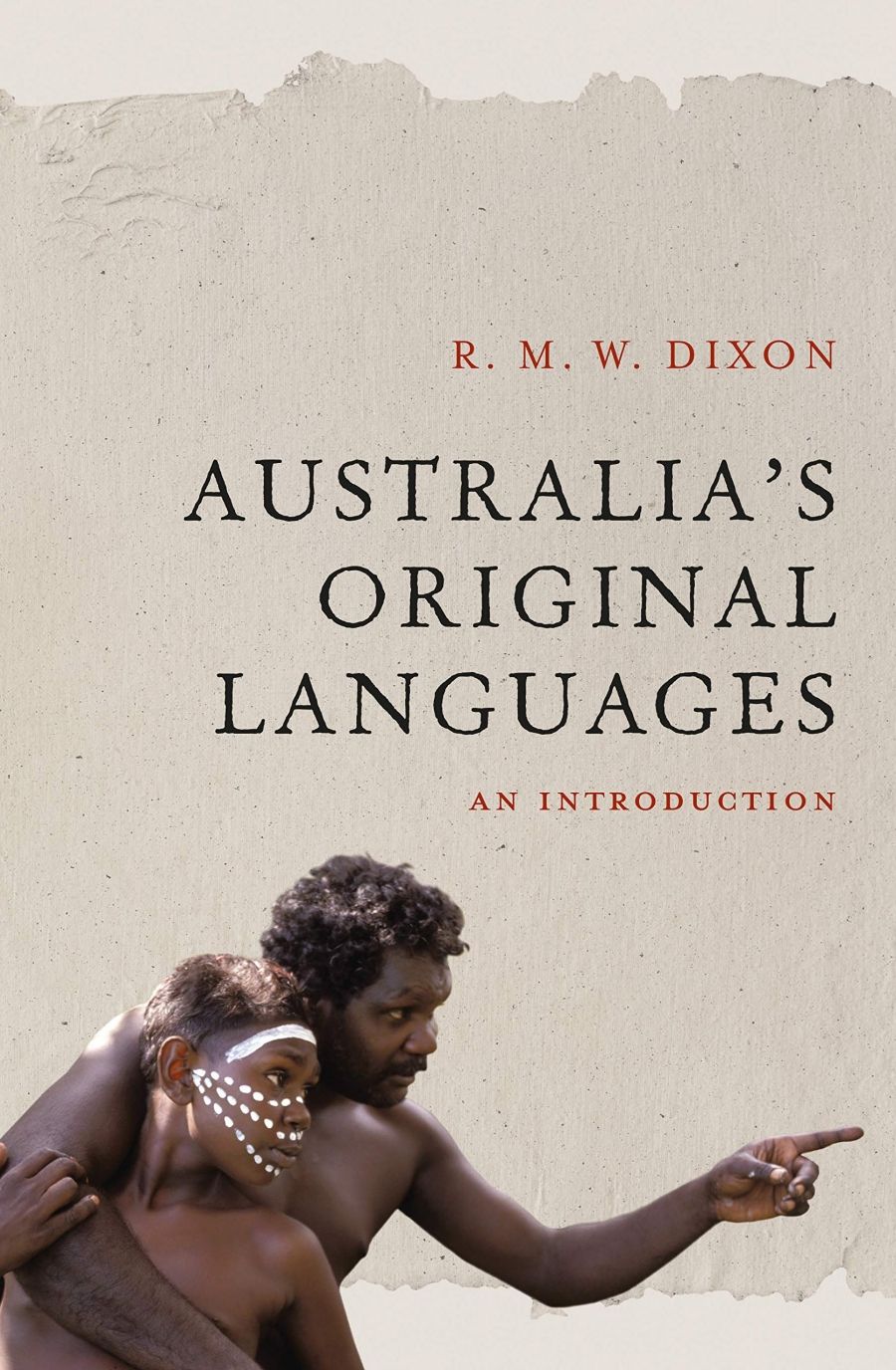
- Free Article: No
- Contents Category: Language
- Custom Article Title: Bruce Moore reviews <em>Australia’s Original Languages: An introduction</em> by R.M.W. Dixon
- Custom Highlight Text:
Bob Dixon has researched Australian Indigenous languages since the 1960s, has constructed grammars of five languages, and has written numerous scholarly books and articles on Aboriginal languages ...
- Book 1 Title: Australia’s Original Languages
- Book 1 Subtitle: An introduction
- Book 1 Biblio: Allen & Unwin, $32.99 pb, 197 pp, 9781760875237
Dixon’s aim is to set the record straight. He provides a timeline. The Indigenous peoples came to Australia more than 50,000 years ago. This is so long ago that we cannot reconstruct what their language was like then. But we can assume that as the people spread out across the land and established separate tribal groups, these groups developed linguistic differences one from the other, and in numerous cases separate languages were created. These languages became as different from one another as English is different from French, German, and Hungarian. They were not mutually intelligible. At the time of the European invasion, there were about 250 of these languages spoken by about 700 groups. There are more groups than languages because some of the discrete languages did have dialects: for example, what is now called the Western Desert language has fifteen dialects, including Luritja, Pintupi, and Pitjantjatjara.
The languages are all very different, but Dixon is concerned to demonstrate some of their typical and core features. For example, there is a chapter on grammatical features, including a discussion of the function of gender in many languages. In his account of gender in Dyirbal (a north Queensland rainforest language), Dixon explains how there is a separate gender for ‘edible plant food’, indicating that even grammatical features can reflect the way a language’s speakers view the world. Technical features are also addressed in a chapter on phonology, with special emphasis on those that will be unfamiliar to people versed in European languages, such as the fact that many Indigenous words begin with the ‘ng’ sound, and the fact that there are usually no phonemic distinctions between the voiceless/voiced pairs p/b, k/g, t/d, so that whereas there is a sense difference between the English kale and gale, there is no such difference between Kaurna and Gaurna (the name of the Adelaide language). Similarly, kookaburra appears in early records as gogobera.
The book is at its most telling when it focuses on the fact that a language both creates and reflects a society and its culture. Attention is paid to the role of language in ceremony, song, and storytelling, but Dixon focuses on less well-known aspects of the social fabric. The complex kinship systems of Aboriginal societies, so different from Western nuclear families in that ‘every member of a community is in a specific relationship with every other member of the community’, mean that a correspondingly complex system of words is necessary to describe the structure. Another common feature of Aboriginal societies is that there were certain classes of kin with whom contact should be avoided, especially in the relationship between a mother-in-law and a son-in-law, and often a special substitute language was used when in one another’s vicinity. Dixon explores some of these avoidance languages. A detailed account of the Warlpiri names used to refer to a male in his transition from child to old man, each name marking a significant change in social role and status, provides a fascinating insight into how language constructs this aspect of Warlpiri society.
Most of the 250 languages are now extinct, and Dixon indicates that only about twenty are surviving strongly, mainly in areas where the colonisers felt no need to exploit the land. The surviving languages have responded to social change in various ways, including developing new terms for new concepts. For example, some languages have simply borrowed the term ‘policeman’ in forms such as buliman, whereas others have adapted existing words, often providing interesting evidence of how words can carry history. In Walmatjarri, the word for ‘policeman’ is limpa: ‘a fly that hovers and suddenly dives in to bite’; in Kalkatungu, it is ganimay-ñjirr: ‘he who ties people up’; in Djapu, it is dhapthap: from a verb meaning ‘clench or grip’, referring to handcuffs; and in Djaru, he is yawadaro wainowadji: ‘the chaining horseman’.
Dixon is acutely aware that all of the remaining languages are threatened, and notes that even in remote areas young speakers are influenced by outside culture, and that they are ‘adopting a reduced form of the traditional language’. Nevertheless, Dixon supports the current efforts to revive languages that are no longer widely spoken, and is participating in revival programs.
In this International Year of Indigenous Languages, it is encouraging to find a leading scholar making such an attempt to explain the nature of Australia’s Indigenous languages to a non-scholarly audience.


Comments powered by CComment